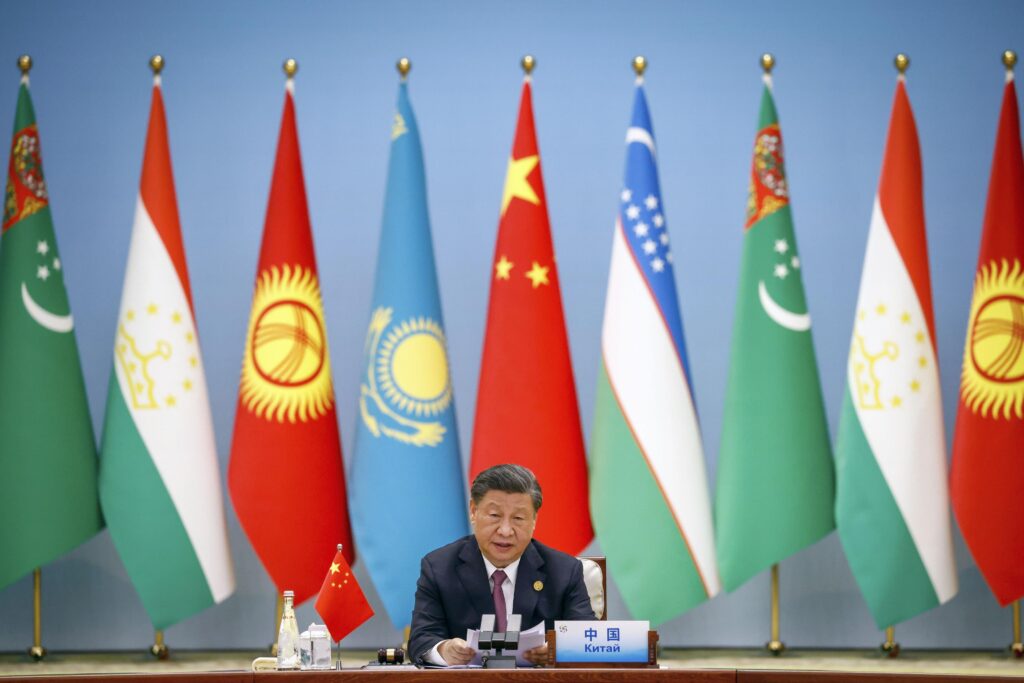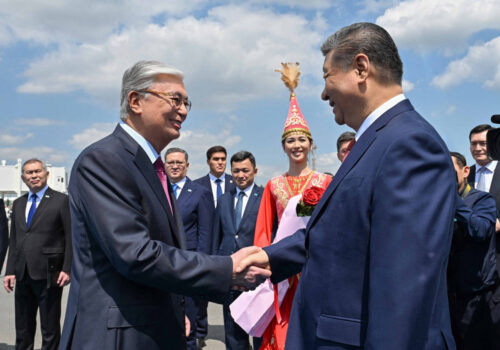China’s growing strength and Russia’s weakening position, partly due to the draining of its resources in its war against Ukraine, are reshaping the geopolitics of Central Asia.
While historically under Russian influence, the five Central Asian states—Kazakhstan, Kyrgyzstan, Tajikistan, Turkmenistan, and Uzbekistan—are now being pulled into growing economic cooperation with China and its Belt and Road Initiative (BRI), albeit with some reservations. Russia’s aggression in Ukraine has strained its capacity for regional engagement while amplifying China’s economic leverage. At the same time, Beijing and Moscow are testing new dimensions and depths to their relationship that could shape their future engagement with Central Asian capitals. It is of concern that Russia could become more involved in Central Asia not only on its own, but in coordination with China.
This complex dynamic creates an opportunity for the United States to deepen its ties with the Central Asian states. Washington should step up its efforts to work with these five countries, leveraging their strategic importance, multi-vector diplomacy, and the ongoing changes in Russia-China relations to foster greater autonomy for the region and to diversify its partnerships. By acting now, the United States can capitalize on the desire among some Central Asian states to reduce their dependence on Russia and China by strengthening economic, diplomatic, and security partnerships with the region.
Expanding the US strategy toward Central Asia
The C5+1 summit in 2023, which brought together the United States and the five Central Asian states, can provide a framework for deeper US engagement. This summit launched a critical minerals dialogue to tap regional resources and reduce dependence on China, alongside commitments to cooperation on counterterrorism and border security. This was followed in March 2024 by the B5+1 business forum in Almaty, which helped to foster private-sector economic links.
To build on these past efforts, the United States should prioritize trade and investment initiatives that counterbalance China’s BRI programs. For instance, supporting Kazakhstan’s oil exports to Western markets, which already diversify its economic ties, can reduce Astana’s reliance on Chinese and Russian markets. Similarly, investing in Uzbekistan’s renewable energy sector, where China has made inroads, would offer an alternative to Beijing’s influence. By providing technical assistance and financing for infrastructure projects, the United States can help Central Asian states resist China’s economic dominance.
While economic diversification is critical, the United States must also address Central Asia’s security concerns to counter Russia’s influence through the Collective Security Treaty Organization (CSTO) and China’s growing security-related presence in the region. This could include border-control measures, counterterrorism training, and intelligence. The United States already provides Foreign Military Financing Border Security Grants and conducts C5+1 Border Security Dialogues with all five states. The United States also administers Antiterrorism Assistance Programs primarily in Tajikistan, Uzbekistan, and Kyrgyzstan. These initiatives could be expanded further to bolster Central Asian defenses while minimizing the risk of provoking Russia. Such measures would not directly challenge existing Russian security ties, but they would help reduce the region’s dependence on the CSTO, particularly in Tajikistan and Kyrgyzstan, where Russia still has significant military bases.
Diplomatic engagement is equally vital. Most of the Central Asian states pursue “multi-vector” foreign policies, balancing Russian security ties with Chinese economic partnerships while avoiding becoming overly reliant on either. Kazakhstan’s neutrality on Russia’s war against Ukraine and Uzbekistan’s diversified energy exports exemplify this approach.
The United States can support this pragmatism by expanding cultural and educational exchanges, such as increasing scholarships for Central Asian students and promoting English-language programs in the region. These initiatives would counter Russia’s soft power, rooted in shared tsarist and Soviet history. It would also address China’s limited cultural appeal in the region, which is hampered by concerns over its treatment of the Uyghur minority in Xinjiang, an issue that resonates negatively in the Muslim-majority Central Asian states.
By supporting internal stability through governance training and anti-corruption initiatives, the United States can help these states resist pressure from Moscow and Beijing. For instance, aiding Kazakhstan’s economic reforms could reduce its reliance on Chinese loans, while technical support for Kyrgyzstan’s small businesses could counter Chinese market dominance. These efforts should be paired with encouraging Central Asian regional cooperation, already at a historic high, in such sectors as trade and energy projects, thus further reducing these states’ vulnerability to Russia and China.
Exploiting Russia-China tensions
The United States must also navigate the Russia-China partnership, which has deepened substantially since 2022. The Kremlin’s ongoing aggression in Ukraine and Russian President Vladimir Putin’s not-so-subtle warning to Kazakhstan when meeting with students at Lake Seliger in the summer of 2014 give Central Asian leaders reasons to be wary about upsetting the Kremlin. Reacting to the 2022 fuel price protests in Kazakhstan, President Kassym-Jomart Tokayev invoked the CSTO for Russian-led “peacekeeping” forces, which were briefly deployed in the country. While the Kazakh was officially supportive of the deployment, the intervention reinforced suspicions that Russia might exploit instability for its own advantage.
However, Russia’s excessive focus on Ukraine limits the economic resources that Moscow can devote to Central Asia, creating a vacuum China has filled with BRI investments. The United States can exploit tensions in this partnership by engaging Central Asian states as neutral partners, allowing the region’s leaders to avoid alignment with either Russia or China. For example, supporting Turkmenistan’s gas exports to Europe via the Trans-Caspian pipeline would diversify its markets beyond China and Russia, enhancing Ashgabat’s autonomy.
When it comes to countering the Russia-China partnership, the United States should play the long game. That does not mean pursuing the simplistic idea of pulling off a “reverse Kissinger” to peel Russia away from China by allowing Putin to have his way in Ukraine. It does mean using the cards that China has put on the table indicating its irridentist claims on Russian territory in the Far East. China’s interest in these territories is understood in Moscow, but it is rarely discussed publicly; Putin wants Beijing’s support as he seeks effective political control in Ukraine.
To be clear, China has never officially repudiated the 2001 Sino-Russian Treaty of Good-Neighborliness and Friendly Cooperation, which explicitly states in Article 6: “The contracting parties—the People’s Republic of China and the Russian Federation—have no territorial claims.” However, a 2024 video clip with millions of views on platforms such as Weibo urged China to seize Siberia if Russia “collapses” and similar posts in 2025 called Siberia “stolen land” ripe for reclamation.
Taking into account core US interests in Europe and Asia, the sensible course is to follow through on US President Donald Trump’s aim to achieve a durable peace in Ukraine. At the same time, the Trump administration should talk quietly with Russia about the Chinese threat to Russian vital interests in its Far East and note US willingness to help with that once peace is established in Ukraine.
Making the US a credible partner in the region
The impact of Russia’s war highlights Central Asia’s strategic dilemma. Russia’s potential retention of Ukrainian territories in any peace deal could enhance its security role but raise fears among Russian neighbors of its territorial ambitions. Meanwhile, China’s economic dominance risks long-term dependency. The United States can help the Central Asian states mitigate these risks by offering a balanced alternative, combining economic incentives, security cooperation, and diplomatic engagement. Unlike Russia and China, the United States can position itself as a partner that respects Central Asian sovereignty without imposing ideological demands.
Indifference is not an option. In Central Asia, a consolidated Russia-China axis would undermine US interests and strengthen a united front that challenges Western influence globally. By investing in the Central Asian states’ energy, infrastructure, and human capital, the United States can foster their resilience and autonomy, positioning Washington as a credible partner in a contested region.
Tatiana Gfoeller is a nonresident senior fellow with the Atlantic Council’s Eurasia Center and member of the board of directors at American Women for International Understanding. From 2008 to 2011, she served as US ambassador to the Kyrgyz Republic.
Further reading
Fri, Aug 15, 2025
What Russia’s war on Ukraine means for Central Asia
New Atlanticist By Tatiana Gfoeller
The course of Russia’s war against Ukraine will have massive implications for Moscow and Beijing’s competition for influence in Central Asia.
Mon, Jun 9, 2025
Turkmenistan’s deepening water crisis could have far-reaching regional consequences
New Atlanticist By
Turkmenistan’s water crisis could have significant economic and political ramifications well beyond its borders.
Tue, Jun 3, 2025
How Kazakhstan can anchor a resilient rare‑earth supply chain for the West
New Atlanticist By
By partnering with Kazakhstan on rare-earth element mining, the United States can reduce its dependence on China and build a more secure critical minerals supply chain.
Image: Chinese President Xi Jinping delivers a speech at the China-Central Asia Summit in Xian in the central Chinese province of Shaanxi on May 19, 2023. (Sultan Dosaliev/Kyrgyz Presidential Press Service/Handout via ReutersConnect)




